*** Updated for February 2025 ***
I first published this page in 18th February 2022.
My new schematics have been drawn from scratch and I have included:
- better resolution – they can be printed on A2 paper (23.4in x 16.5in) without any loss of quality.
- sized for UK and Europe – originally the page was sized for US Legal (14in x 8.5in) paper, and resizing for A4/A3/A2 standard didn’t work.
- cable colours were confusing – it was difficult to see what was the dominant colour ‘vs’ what was the trace colour.
- for MK3 move the key switch from the right to the left side of the page.
- show the warning lamp colours.
- lighter background – ideally there would be no background, but as there are a lot of white cables this would make it difficult to read. I have lightened up the background, and outlined the white cables, it works much better for printing now.
- make points/condenser arrangement clearer.
- show terminals on turn signal flasher unit.
- group additional fuses on early MK3 schematic.
- improved labelling.
There are numerous other small improvements too, which make the schematics easier to read.

Ignition
A really popular Norton Commando upgrade is to move from the old points-based ignition system over to Electronic Ignition.
One of the most common units of the time is Boyer Bransden, who have been around since 1969.
Boyer Bransden are still going today, and their website can be found here.
Moving from points to Boyer electronic ignition is a pretty simple upgrade.
From a wiring perspective, the most important thing to note is that you will be moving from a pair of coils that are wired in parallel to series.
Originally, the points make and break the positive (earth) side of each coil in turn.
The Boyer electronic ignition system uses a concept called “wasted spark” – with the two coils wired in series, they are energized together on every rotation of the camshaft.
You’ll note in the wiring diagrams below that the Ballast Resistor and Condensers have been removed as part of the conversion to Electronic Ignition.
The color coding of the wiring is simple:
| Wire Colour | Description |
|---|---|
| Red | this is the positive feed to the Boyer, and is usually picked up from the red wire that goes to the Coil positive terminal |
| Black | this is the negative supply FROM the Boyer TO the coils |
| White | this is the negative feed to the Boyer – it joins in to the White/Blue wire that used to feed the Ballast Resistor that you are removing. As standard, this goes up to the big connector block under the tank, where it’s joined to the White/Yellow that is the kill switch on your left side handlebar switch cluster. If the white/yellow is long enough, you can connect the white wire of the Boyer directly to it! |
| Black/Yellow and Black/White | these go from the Boyer black box (they call it the Transistor Box) down to the Stator Plate that sits behind the points cover. |
The Boyer Bransden Micro MKIV is the current iteration of their Electronic Ignition system, and offers a few improvements over the MKIII – including a slightly optimized timing curve which improves stability at engine start, plus the ability for the electronics to run at lower voltages (10 volts)
The old Boyer MKIII liked a good, strong 12 volts, and this was the cause of backfiring, particiuarly on the Electric Start Commando MK3
The Instructions specific to the Norton Commando that come with the Boyer Bransden Micro MarkIV can be found here:
Here is the Boyer Bransden Micro MKIII General Information Sheet
Here is the Boyer Bransden Micro MKIV General Information Sheet
Charging
One of the most common upgrades or modifications for a classic british bike is to add a combined regulator/rectifier unit.
Our Commandos use a blue can capacitor, zener diode (which can be found mounted on the back of the z-plate) and rectifier unit.
A combined regulator/rectifier replaces all of these components with one package.
Boyer Bransden are also popular manufacturer of aftermarket regulator/rectifiers with their Power Box units which are available in single phase, three phase and high power versions.
Bike owners that have gone up the route of Boyer electronic ignition often choose to install the Boyer reg/rec too, as many like them to match.
However, one very important thing to note, which often gets overlooked is that the Boyer Bransden Power Box is not compatible with the Warning Light Assimilator used on the Norton Commando.
You can see in the note below:
If your Norton has a charging warning light simulator it must not be used with the
power box, remove it. If the light control is required fit the power box type
PBOX00166 with charging light control.
While the wording is poorly put, and the grammar is bad, the message is very clear.
You can see the original instructions here:
As you can see in the instructions, Boyer Bransden sell a different Power-Box unit, if you want to continue and use the red warning light to show charge. It is the PBOX00166 model.
The Instructions that come with the PBOX00166 Boyer Bransden Power_box regulator/rectifier with charging light control can be found here:
There are six wires to connect:
| Wire Colour | Description |
|---|---|
| Yellow (x 2) | these are the AC inputs and pick up on the Green/Yellow and Green/White (connection can be any way round, as this is the AC side of the circuit) |
| Red | this is the Positive output and will join to the red wire if you are using existing wiring (it goes straight to the ground/earth of the frame) |
| Black | this is the Negative output (known as the hot wire) – it will pick up on the Brown/Blue wire (which goes via a fuse straight to the battery negative terminal) |
| White | this is the positive feed to the warning lamp – it is switched by the reg/rec based on the presence of an AC output from the stator |
| Red/White | this is linked in to the Red ground lead |
Note – the wiring is the same for both the Boyer Bransden Micro MKIII and Micro MKIV systems.
1968 Norton Commando Wiring Schematic + Boyer Bransden electronic ignition AND regulator/rectifier
These are the pre-1971 bikes and have the ammeter in the headlight shell, as well as the Wipac Triconsul type handlebar switch.
The wiring is very simple, and more like the Atlas than what came to be familiar with the Commando.
Note that I have included the Front Brake Switch as standard – this was a US requirement, that didn’t appear on the earliest UK bikes.
It is worth noting that the early bikes were fitted with 12 volt coils. These MUST be replaced for the later 6 volt coils (fitted from 1970 onwards) for Electronic Ignition to work reliably.
1968 Norton Commando Wiring Schematic + Boyer Bransden electronic ignition AND regulator/rectifier PNG 5600×3960
This diagram is also downloadable as a PDF from HERE
1971 Norton Commando Wiring Schematic + Boyer Bransden electronic ignition AND regulator/rectifier
This is often referred to as the “Interim” model.
It is distinguishable by the three pin master switch (ignition key switch) which was Lucas part number LU39565.
These were made ONLY for the Norton Commando, and are no available as an aftermarket replacement.
If you are not comfortable rebuilding the switch, most people choose to go for the LU30552, which IS readily available.
You can find an article on ignition switches here, that may be of interest.
1971 Norton Commando Wiring Schematic + Boyer Bransden electronic ignition AND regulator/rectifier PNG 5600×3960
This diagram is also downloadable as a PDF from HERE
1972 onwards Norton Commando Wiring Schematic + Boyer Bransden electronic ignition AND regulator/rectifier
The 1972 onwards schematic covers 750 and 850 bikes and has the much more familiar four pin master switch (ignition key switch)
1972 onwards Norton Commando Wiring Schematic + Boyer Bransden electronic ignition AND regulator/rectifier PNG 5600×3960
This diagram is also downloadable as a PDF from HERE
MK3 Commando
During the manufacture of the MK3, Norton and Triumph were coming together, and they were often feeding from the same parts bins.
We have noted some anomalies between the handlebar switches while the MK3 was in production, as they frequently used the Triumph T140E switches, which look the same, but have a couple of small wiring differences.
Left handlebar switch the U (blue) used by Norton (and illustrated in the factory workshop manual) has been replaced with a UY (blue/yellow) cable. This connects to the U (blue) of the right handlebar switch inside the headlamp bucket.
Right handlebar switch there is no S (slate grey) instead, the single “hot” negative from the pin 2 of the Master Switch (ignition key switch) is jumpered for both engine run/kill switch and the starter button.
Another element of the MK3 that sometimes causes confusion is the wiring around the Warning lights.
The factory workshop manual shows the following:
I have covered this in more detail in a separate article, which can be found here.
But in short, the cable colors used for the sub-console wiring harness were not the same all the way through MK3 production – so certainly something to watch out for!
1974 Norton MK3 Commando (Early) Wiring Schematic + Boyer Bransden electronic ignition AND regulator/rectifier
1974 MK3 Early Bikes – there were around 2,000 bikes that were built around the December 1974 timeframe that have three additional fuses that can be found in the headlamp bucket.
These bikes are also wired with the old Lucas 3AW 3 wire ‘silver can’ assimilator.
1974 Norton MK3 Commando (Early) Wiring Schematic + Boyer Bransden electronic ignition AND regulator/rectifier PNG 5600×3960
This diagram is also downloadable as a PDF from HERE
1975 Norton MK3 Commando Wiring Schematic + Boyer Bransden electronic ignition AND regulator/rectifier
This is the most common configuration, and takes us through to the final Commando that rolls off the production line.
1975 Norton MK3 Commando Wiring Schematic + Boyer Bransden electronic ignition AND regulator/rectifier PNG 5600×3960
This diagram is also downloadable as a PDF from HERE
1975 Norton MK3 Commando (Canadian Market) Wiring Schematic + Boyer Bransden electronic ignition AND regulator/rectifier
For the Canadian Market, there were legal requirements around the headlamp being on while the engine was running.
The wiring diagram includes changes needed (swapping out the Warning Light Assimilator 06-6393 for the Headlamp Warning Unit 06-6392).
Note that a different Master Switch (ignition key switch) is also required – the key switch differences for Canada are covered here in a separate article.
This is covered in the Factory Wiring Diagram, by notes.
While the Headlamp Warning Unit is available from our friends at Andover Norton, the Canadian key switch LU30825 is not available, and must be rebuilt manually.
1975 Norton MK3 Commando (Canadian Market) Wiring Schematic + Boyer Bransden electronic ignition AND regulator/rectifier PNG 5600×3960
This diagram is also downloadable as a PDF from HERE
NOTE:
A couple of points about the way these diagrams have been drawn:
- The diagrams on my site are schematics – the components are not drawn in the physical location on the bike. Instead they are drawn in locations that make the diagram the easiest and most logical to follow.
- Where the same colour wire goes in to and out of a single connector, that connector has usually been omitted from the drawing.
It’s obvious on the bike, is easy to spot and easy to troubleshoot.
Leaving them off the diagrams makes them a LOT easier to read, and considerably less cluttered. - Wherever the earth or ground side of a component goes back to the battery, the drawing shows a red earth symbol:

In reality, this could be connected either to a red wire in the bike’s wiring harness (loom) OR it could be attached to the frame or engine of the bike.
I have shown the red earth symbol each time in order to massively simplify the diagram, and make it a lot easier to understand for everyone.
I have also coloured them red as a gentle reminder that these bikes are wired positive earth!
This article is from a series of four covering Boyer Bransden products:
- Norton Commando Wiring Diagram with Boyer electronic ignition
- Norton Commando Wiring Diagram with Boyer reg/rec
- Norton Commando Wiring Diagram with Boyer electronic ignition and reg/rec
- Norton Commando Wiring Diagrams with Boyer electronic ignition – with 12 volt coils
As always don’t hesitate to reach out if you need any help or advice.
Categories: Aftermarket Upgrades, motorcycles

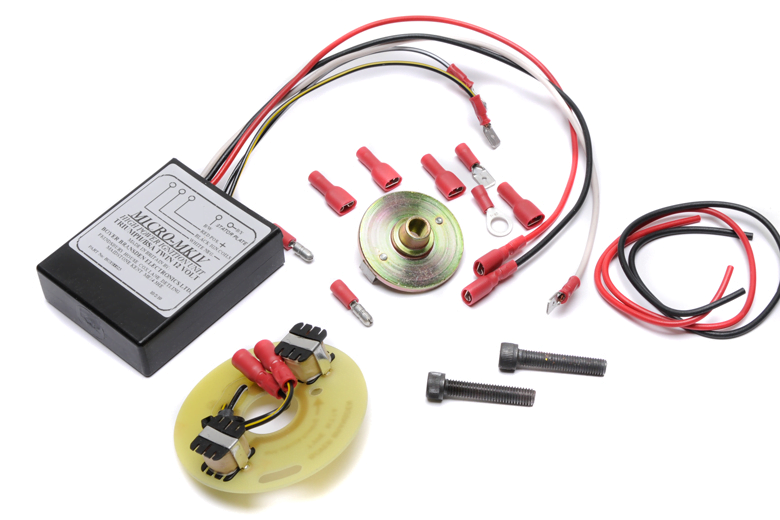


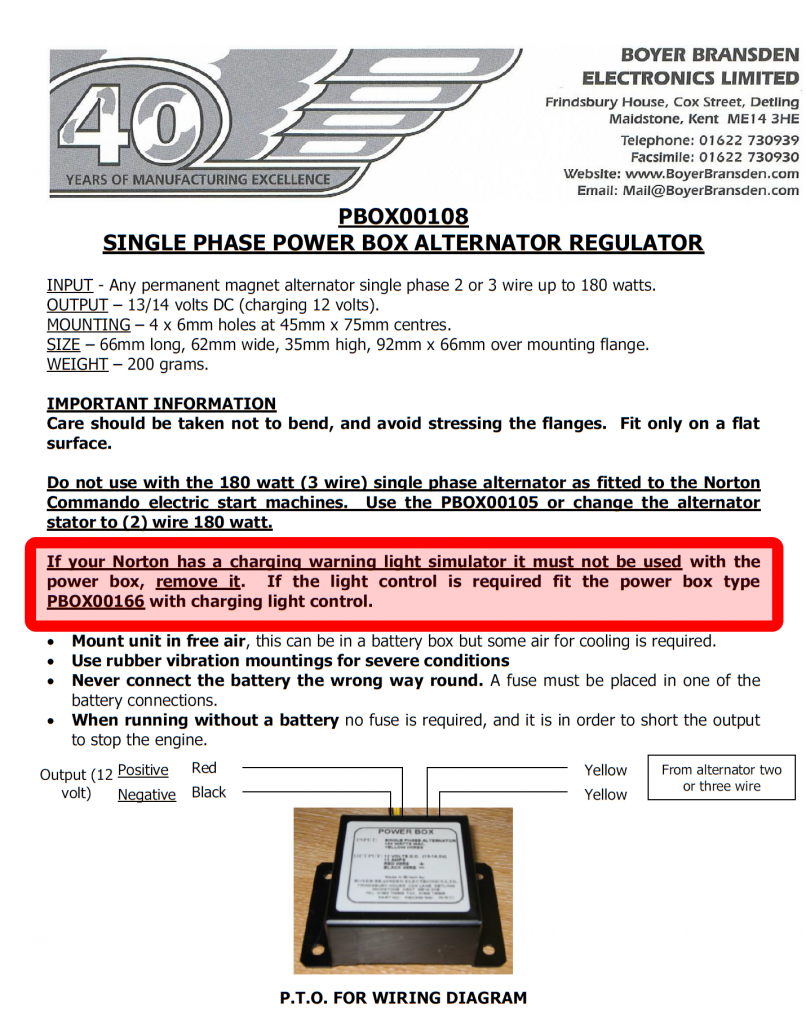

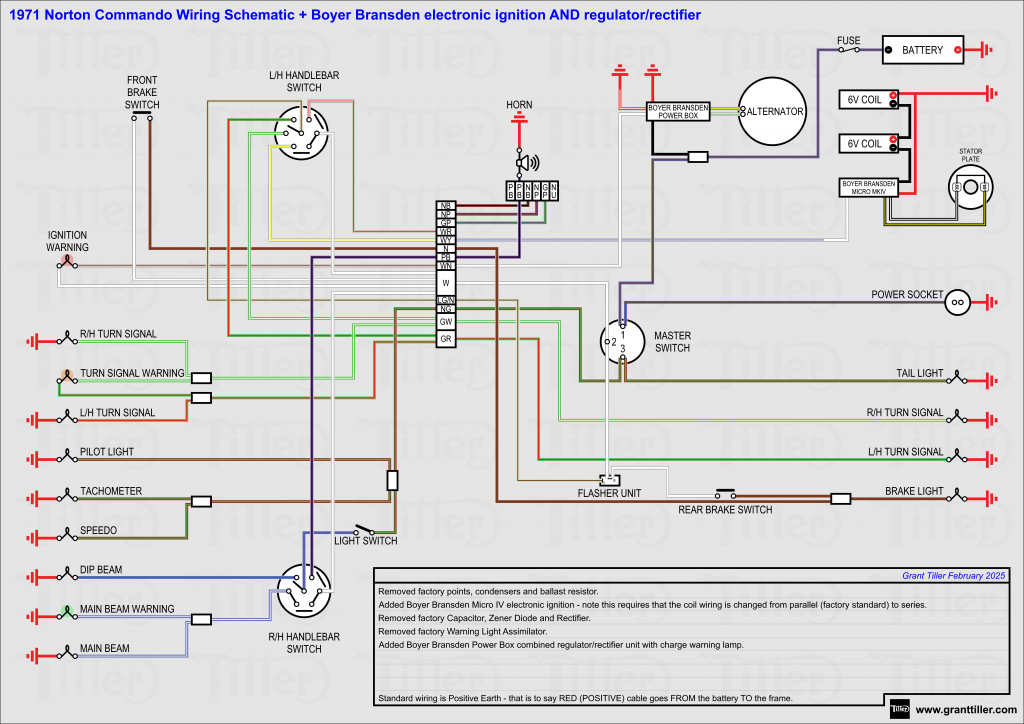




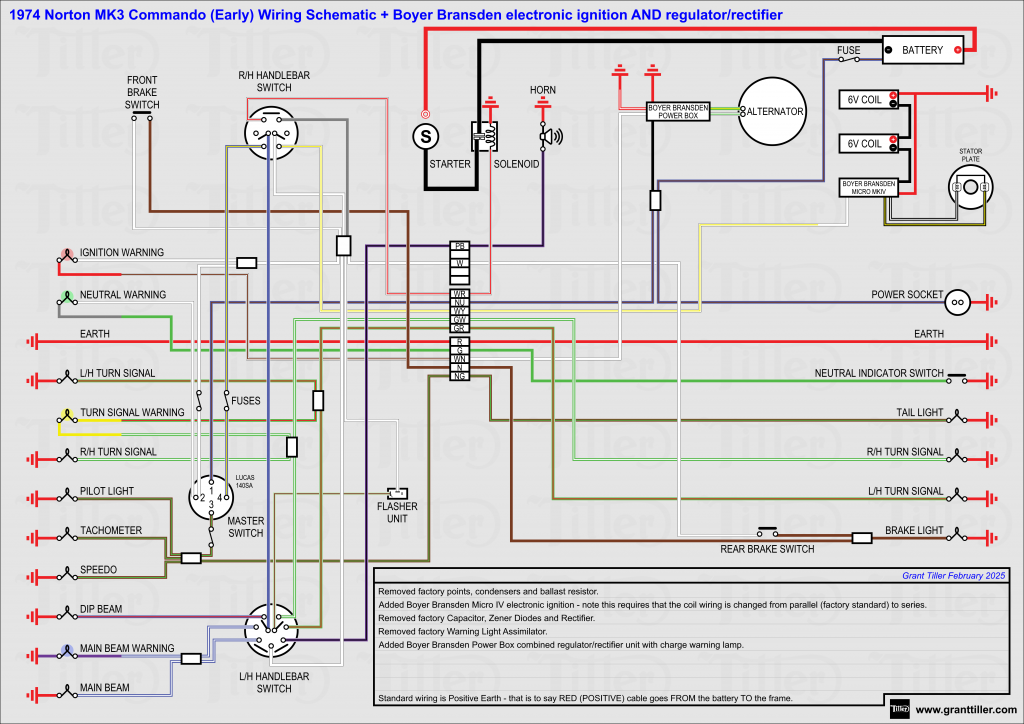
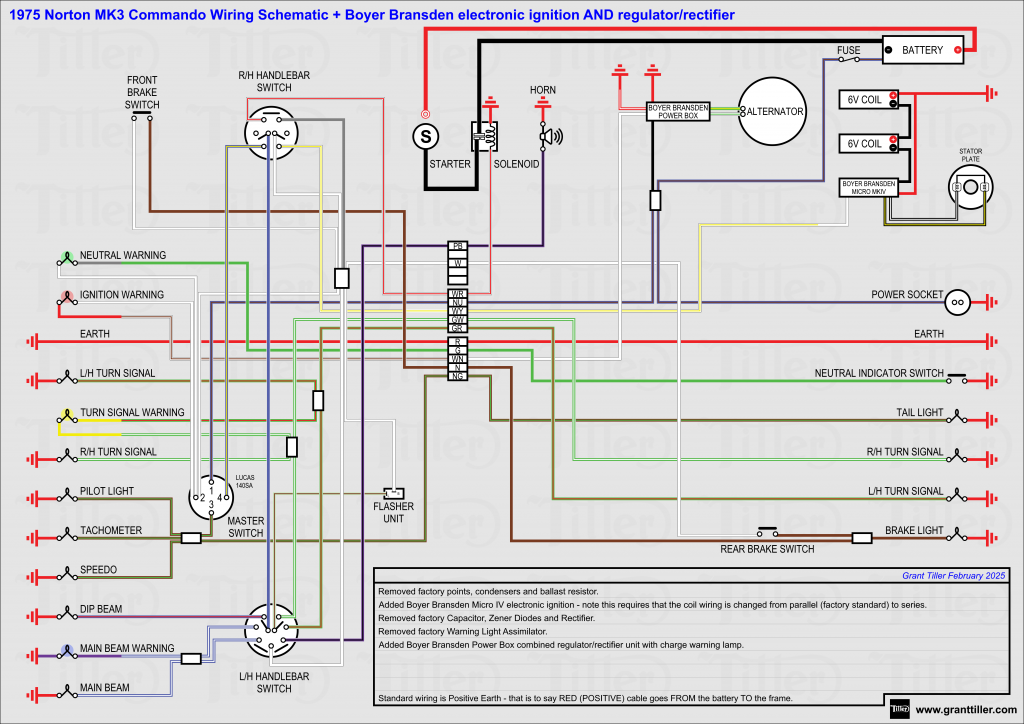

1 reply ›